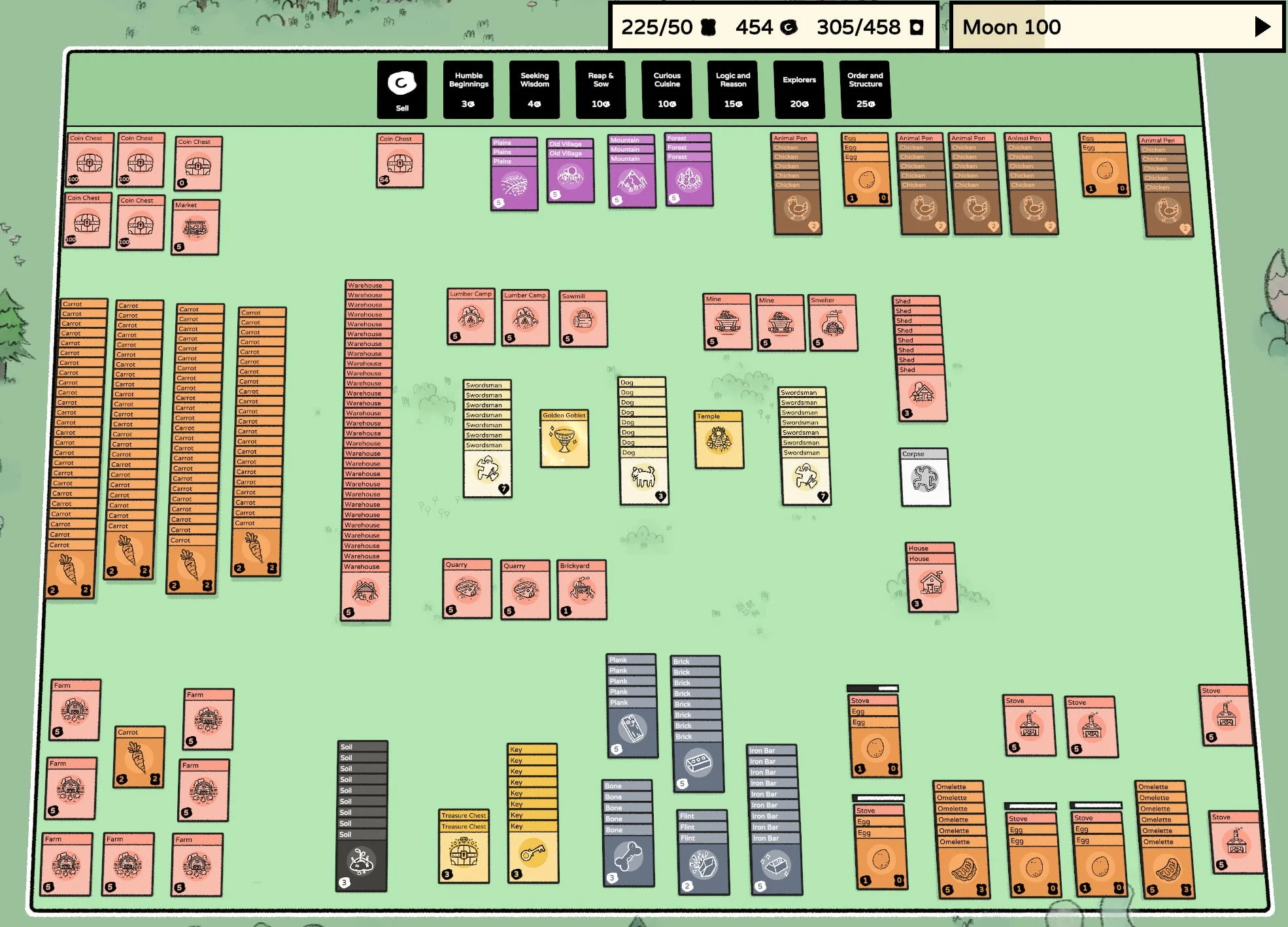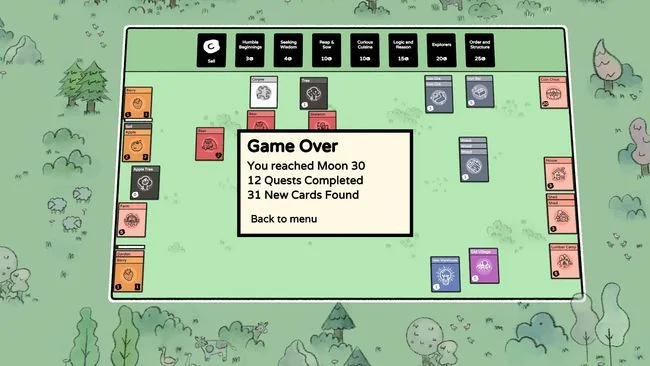Welcome Stacklanders!
After completing the game a couple of times and having a ton of fun with it, I thought I’d share my most useful tips and tricks for beginners. The different recipes are marked as spoilers. Have fun! 🙂
Early Game
1) PAUSE is your friend!
The game can get quite stressful and overwhelming when all the cards move around the board and animals jump through your organized stacks. Just pause, take a breath and make your decisions then. You can rearrange your cards, assign your villagers on new tasks, buy or sell cards and fill your garden or soil with new vegetables – all in pause mode. I spend a lot of time in pause mode myself, and the game is definitely more relaxing this way. 🙂
To pause, press the spacebar on your keyboard or cycle through the time modes in the upper right corner of the screen. (Standard speed -> faster speed -> pause)
2) Keep your villagers busy
As long as your villagers are always producing or crafting something, you will progress further ahead. Even if you don’t need a certain resource, you may still sell it in the top left corner and gain a gold. If you run out of things to do, buy the very first pack (Humble Beginnings) for 3 gold. It is cheap, gives all the basic materials you need and your villagers can continue to break down resources or craft advanced recipes.
3) How to stay alive?
A) Build gardens to plant new vegetables. If you got a soil from one of the packs – great! Instead of using it to plant a vegetable directly in it, craft a garden to have a permanent card to plant on.
Recipe for a garden: 1 soil + 2 stone + 2 wood
B) If you get a rabbit, let it live and let it poop. 🙂 The bunnies will poop, which you can use like a soil. You can plant a vegetable or fruit on the poop to multiply the food.
4) How to earn money?
Buying packs is important. You need money for that. Try to process your resources before you sell them, this will give you more money in general. Try processing wood and stone with a villager, either one at a time or in batches of 3.
For the food recipes, it depends a bit on the resources and animals you have available: (Reap and Sow pack recommended)
A) The easiest recipe for me unlocks as soon as you get a cow. Recipe for a milkshake: 1 berry + 1 milk, sells for 5 gold.
B) Another great recipe with a chicken is the omelet: 2 eggs placed on a campfire, sells also for 5 gold.
C) The third good recipe is the fruit salad: 1 berry + 1 apple, also sells for 5 gold.
Mid Game
5) Expand your storage
You will gain new items fast now. The most frustrating thing to do at the end of a day is to sell all your hard earned materials and foods. Build up a lot of sheds to gain more freedom on your board.
Recipe for a shed: 1 wood + 1 stone + 1 stick. Very easy to craft and worth it.
6) Gear up!
Be careful now. Soon, there will be enemies spawning that will attack your villagers. Make at least two militia and have them ready to defend if an attack happens. Recipie for a spear: 1 wood + 2 sticks. Place the spear on a villager to equip it.
As soon as you have a couple of iron bricks, convert your militia to swordsmen. Recipe for a sword: 1 iron brick + 2 sticks
7) Where to get iron ore/ iron bars from?
Part 1: Getting the iron ore
Iron is a precious resource that you cannot get your hands on easily. If you get an iron bar or ore early on, keep it! You may get an iron bar from a traveling merchant, for example.
If you didn’t get lucky, there are still multiple ways to get an ore:
A) Buy the Order and Structure pack. Yes, it is expensive, but the chances of getting an iron ore deposit (~3 iron ore when processed) are super high and definitely worth it.
B) Mine it yourself: You can craft a mine, which you can use to decently farm iron ore from.
Recipe for a mine: 2 flint + 1 wood + 1 stone
C) Less good, but still viable: Logic and Reason pack. It has a decent chance of dropping a single iron ore
D) My least favorite way to farm iron deposits (dangerous): Buy some Explorer packs until you find a mountain. Send a militia or swordsman to explore it. There is a decent chance of finding iron deposits. But be careful: In the explorers pack itself and in the mountains may be enemies. Have your trained warriors at the ready. 🙂
Part 2: Smelting the iron ore into an iron bar
You need a smelter to process the iron ores into iron bars.
Recipe for a smelter: 2 flint + 2 brick + 1 plank. Place a wood and an ore in it and it automatically starts processing it into a bar.
End Game
8) Massively expand your storage
You need space to stack up food. Build warehouses, many, and then build even more.
Recipes for warehouses: 1 stone + 1 iron bar. Easy, right? Do it
9) Specialize units
The enemies will become powerful and your normal villagers vulnerable if caught off guard. Use the iron bars to gear up your villagers to swordsman. Also convert your militia. Yes, you will loose the resources spent on the spear, but a dead villager will hurt you way more. You have to keep in mind that a swordsman will eat 3 food instead of 2 per day, so be ready for that.
Use villagers (or dogs) only on the lumber camp and the quarry to get a steady supply of wood and stone. I personally prefer having two of each production building, but then use the dogs to run it and convert all my villagers to swordsman 🙂
How to get a dog: Give a wild wolf a bone. Wolfs ocasionally come out of plains (Explorer Pack)
10) Minimize your actions
Yes, it is nice to have carrots and berries and onions and apples and all kinds of processed food, but you have to manage all the different food sources independently and it will require a lot of your attention and space on the board.
My recommendation would be to concentrate on 2 sources of food and only generate food this way. As shown in the screenshot, I used carrots (no villager interaction needed) and chickens/ omelets only to sustain a large amount of people and dogs. To get an apple or a berry, you need to first place the fruit on the soil and later process the tree/bush with a villager. This locks your people into the food production and you need to interact twice to create the food. If you then make a fruit salad, you had to click a third time. There’s the big advantage of carrots in my opinion: just place them on a garden/ farm and watch them multiply by itself. They also provide 2 food, which makes them better than onions. Chickens are nice too, as they give you eggs for free and you have to only drag them on the campfires/ stoves. Great way to make money or feed your people. (5 gold, 3 food)

Bonus tip
If you place a coin chest directly below the sell card, the money will automatically enter the chest as long as there’s space for it. Makes your life a bit easier.
Recipe for a coin chest: 2 wood + 1 coin
Bonus tip 2
Tell the game where you want your cards to go, instead of them just randomly plopping out in different directions and messing up your board. The game always tries to stack up the cards for you. If you leave a single card close to the building that produces it, the following cards will stack up there. As shown in the image above, you can have a couple of farms around a vegetable, or a couple of stoves around a meal. As soon as the process is finished, the product will stack on top of the single card you positioned there. Of course, this also works for lumber camps with wood, or quarries with stone, and so on.
